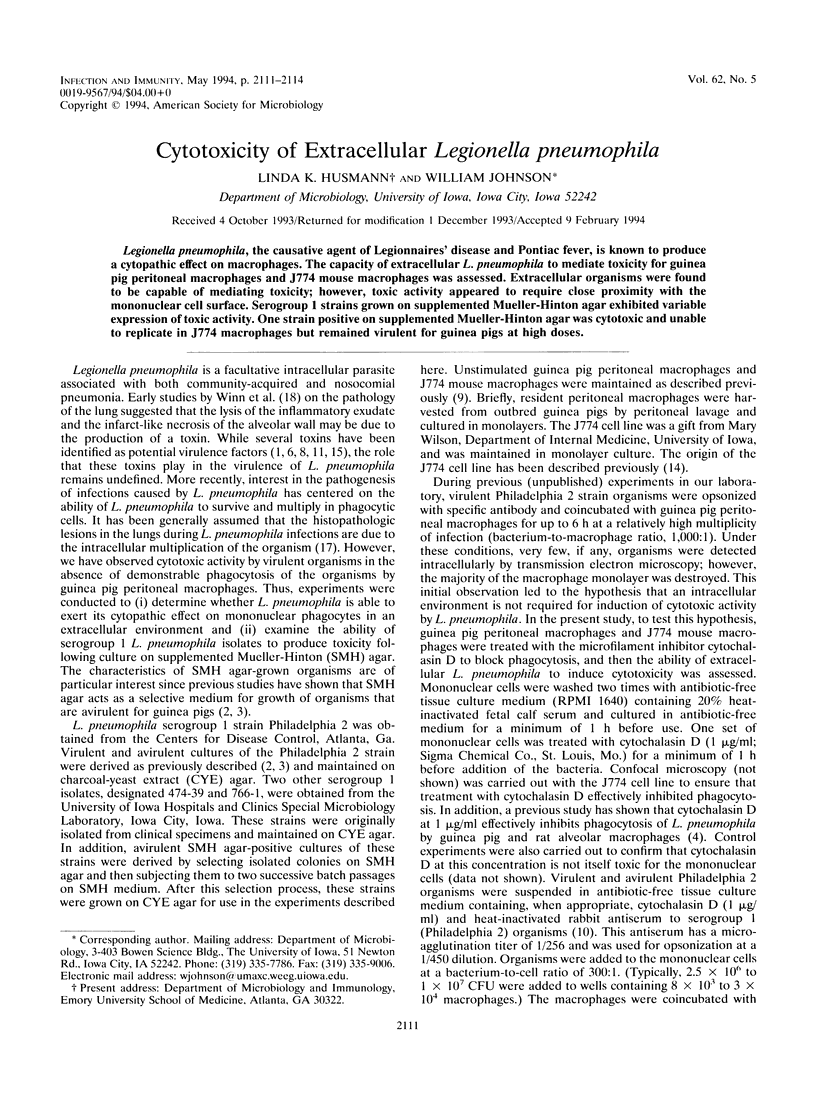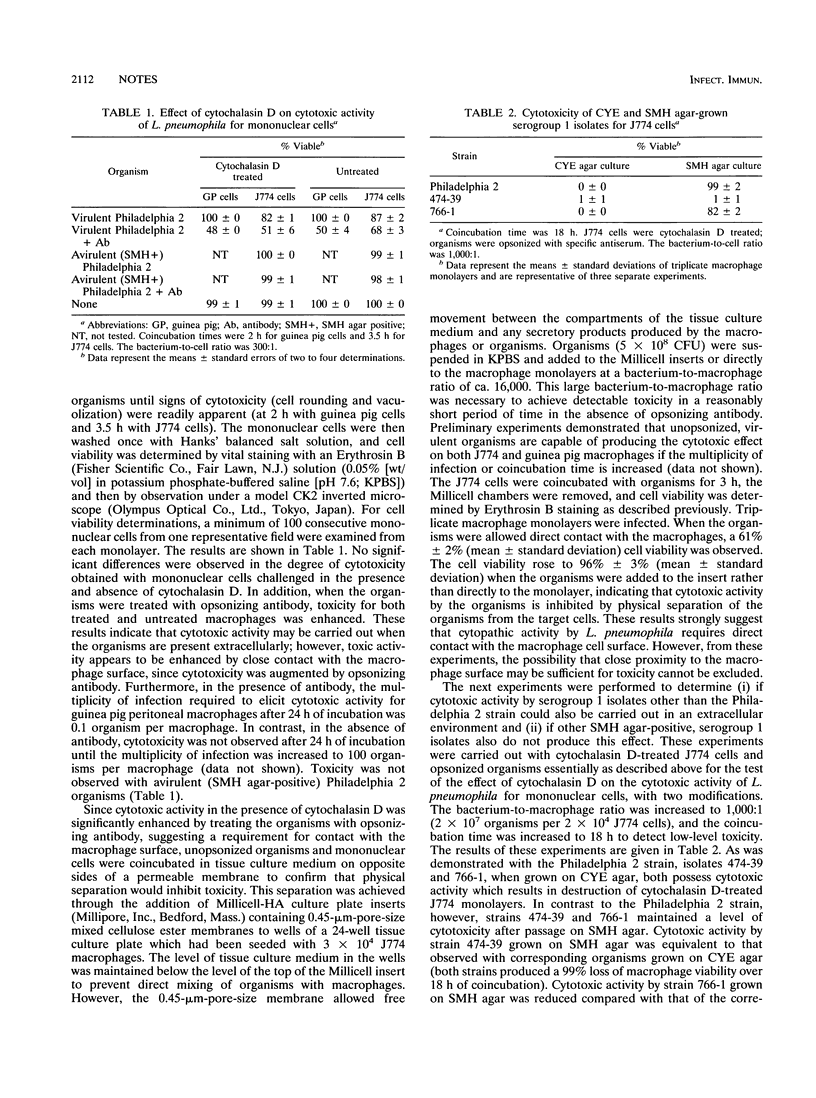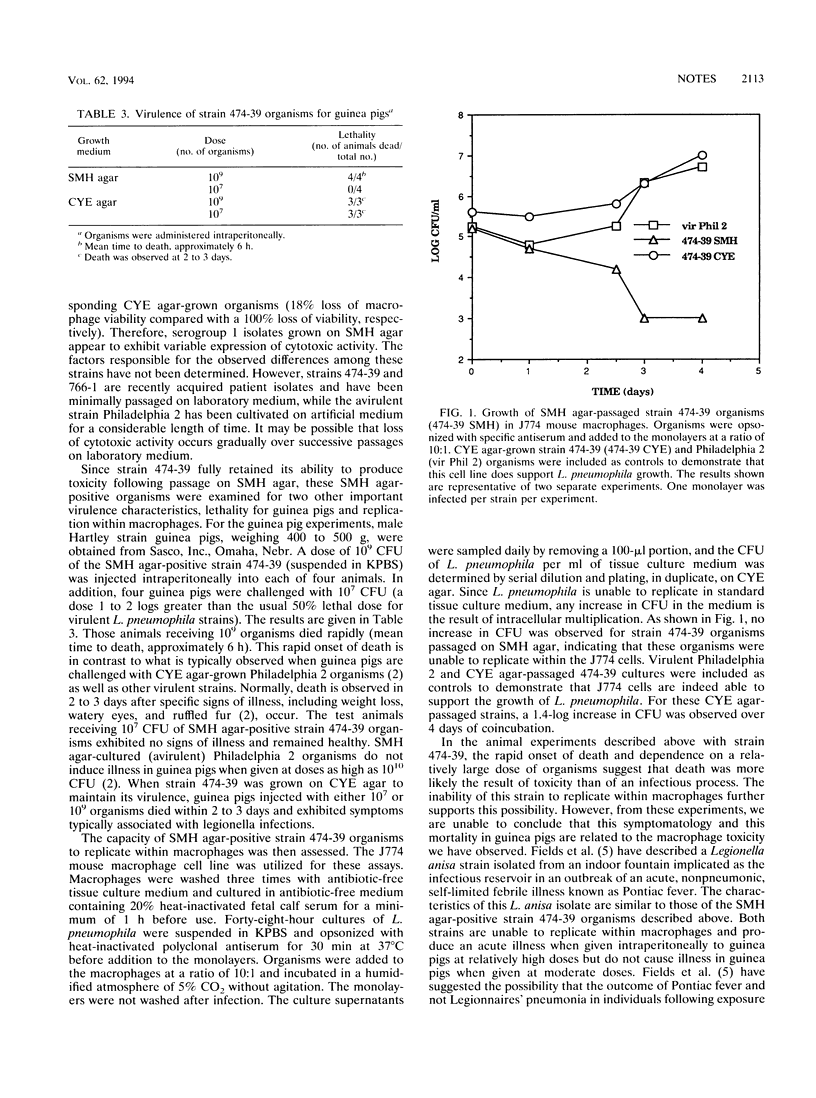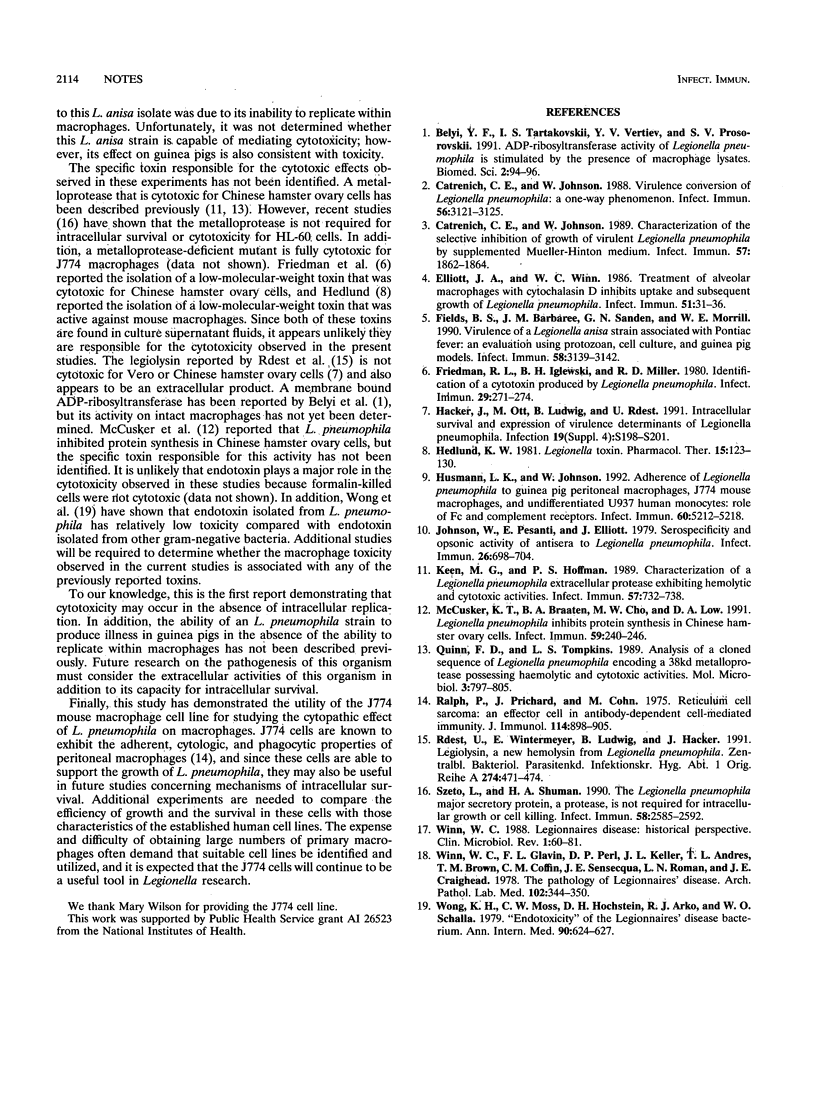Abstract
Legionella pneumophila, the causative agent of Legionnaire's disease and Pontiac fever, is known to produce a cytopathic effect on macrophages. The capacity of extracellular L. pneumophila to mediate toxicity for guinea pig peritoneal macrophages and J774 mouse macrophages was assessed. Extracellular organisms were found to be capable of mediating toxicity; however, toxic activity appeared to require close proximity with the mononuclear cell surface. Serogroup 1 strains grown on supplemented Mueller-Hinton agar exhibited variable expression of toxic activity. One strain positive on supplemented Mueller-Hinton agar was cytotoxic and unable to replicate in J774 macrophages but remained virulent for guinea pigs at high doses.
Full text
PDF



Selected References
These references are in PubMed. This may not be the complete list of references from this article.
- Belyi YuF, Tartakovskii I. S., Vertiev YuV, Prosorovskii S. V. ADP-ribosyltransferase activity of Legionella pneumophila is stimulated by the presence of macrophage lysates. Biomed Sci. 1991;2(1):94–96. [PubMed] [Google Scholar]
- Catrenich C. E., Johnson W. Characterization of the selective inhibition of growth of virulent Legionella pneumophila by supplemented Mueller-Hinton medium. Infect Immun. 1989 Jun;57(6):1862–1864. doi: 10.1128/iai.57.6.1862-1864.1989. [DOI] [PMC free article] [PubMed] [Google Scholar]
- Catrenich C. E., Johnson W. Virulence conversion of Legionella pneumophila: a one-way phenomenon. Infect Immun. 1988 Dec;56(12):3121–3125. doi: 10.1128/iai.56.12.3121-3125.1988. [DOI] [PMC free article] [PubMed] [Google Scholar]
- Elliott J. A., Winn W. C., Jr Treatment of alveolar macrophages with cytochalasin D inhibits uptake and subsequent growth of Legionella pneumophila. Infect Immun. 1986 Jan;51(1):31–36. doi: 10.1128/iai.51.1.31-36.1986. [DOI] [PMC free article] [PubMed] [Google Scholar]
- Fields B. S., Barbaree J. M., Sanden G. N., Morrill W. E. Virulence of a Legionella anisa strain associated with Pontiac fever: an evaluation using protozoan, cell culture, and guinea pig models. Infect Immun. 1990 Sep;58(9):3139–3142. doi: 10.1128/iai.58.9.3139-3142.1990. [DOI] [PMC free article] [PubMed] [Google Scholar]
- Friedman R. L., Iglewski B. H., Miller R. D. Identification of a cytotoxin produced by Legionella pneumophila. Infect Immun. 1980 Jul;29(1):271–274. doi: 10.1128/iai.29.1.271-274.1980. [DOI] [PMC free article] [PubMed] [Google Scholar]
- Hacker J., Ott M., Ludwig B., Rdest U. Intracellular survival and expression of virulence determinants of Legionella pneumophila. Infection. 1991;19 (Suppl 4):S198–S201. doi: 10.1007/BF01644033. [DOI] [PubMed] [Google Scholar]
- Hedlund K. W. Legionella toxin. Pharmacol Ther. 1981;15(1):123–130. doi: 10.1016/0163-7258(81)90021-8. [DOI] [PubMed] [Google Scholar]
- Husmann L. K., Johnson W. Adherence of Legionella pneumophila to guinea pig peritoneal macrophages, J774 mouse macrophages, and undifferentiated U937 human monocytes: role of Fc and complement receptors. Infect Immun. 1992 Dec;60(12):5212–5218. doi: 10.1128/iai.60.12.5212-5218.1992. [DOI] [PMC free article] [PubMed] [Google Scholar]
- Johnson W., Pesanti E., Elliott J. Serospecificity and opsonic activity of antisera to Legionella pneumophila. Infect Immun. 1979 Nov;26(2):698–704. doi: 10.1128/iai.26.2.698-704.1979. [DOI] [PMC free article] [PubMed] [Google Scholar]
- Keen M. G., Hoffman P. S. Characterization of a Legionella pneumophila extracellular protease exhibiting hemolytic and cytotoxic activities. Infect Immun. 1989 Mar;57(3):732–738. doi: 10.1128/iai.57.3.732-738.1989. [DOI] [PMC free article] [PubMed] [Google Scholar]
- McCusker K. T., Braaten B. A., Cho M. W., Low D. A. Legionella pneumophila inhibits protein synthesis in Chinese hamster ovary cells. Infect Immun. 1991 Jan;59(1):240–246. doi: 10.1128/iai.59.1.240-246.1991. [DOI] [PMC free article] [PubMed] [Google Scholar]
- Quinn F. D., Tompkins L. S. Analysis of a cloned sequence of Legionella pneumophila encoding a 38 kD metalloprotease possessing haemolytic and cytotoxic activities. Mol Microbiol. 1989 Jun;3(6):797–805. doi: 10.1111/j.1365-2958.1989.tb00228.x. [DOI] [PubMed] [Google Scholar]
- Ralph P., Prichard J., Cohn M. Reticulum cell sarcoma: an effector cell in antibody-dependent cell-mediated immunity. J Immunol. 1975 Feb;114(2 Pt 2):898–905. [PubMed] [Google Scholar]
- Rdest U., Wintermeyer E., Ludwig B., Hacker J. Legiolysin, a new hemolysin from L. pneumophila. Zentralbl Bakteriol. 1991 Jan;274(4):471–474. doi: 10.1016/s0934-8840(11)80083-6. [DOI] [PubMed] [Google Scholar]
- Szeto L., Shuman H. A. The Legionella pneumophila major secretory protein, a protease, is not required for intracellular growth or cell killing. Infect Immun. 1990 Aug;58(8):2585–2592. doi: 10.1128/iai.58.8.2585-2592.1990. [DOI] [PMC free article] [PubMed] [Google Scholar]
- Winn W. C., Jr, Glavin F. L., Perl D. P., Keller J. L., Andres T. L., Brown T. M., Coffin C. M., Sensecqua J. E., Roman L. N., Craighead J. E. The pathology of Legionnaires' disease. Fourteen fatal cases from the 1977 outbreak in Vermont. Arch Pathol Lab Med. 1978 Jul;102(7):344–350. [PubMed] [Google Scholar]
- Winn W. C., Jr Legionnaires disease: historical perspective. Clin Microbiol Rev. 1988 Jan;1(1):60–81. doi: 10.1128/cmr.1.1.60. [DOI] [PMC free article] [PubMed] [Google Scholar]
- Wong K. H., Moss C. W., Hochstein D. H., Arko R. J., Schalla W. O. "Endotoxicity" of the Legionnaires' disease bacterium. Ann Intern Med. 1979 Apr;90(4):624–627. doi: 10.7326/0003-4819-90-4-624. [DOI] [PubMed] [Google Scholar]


